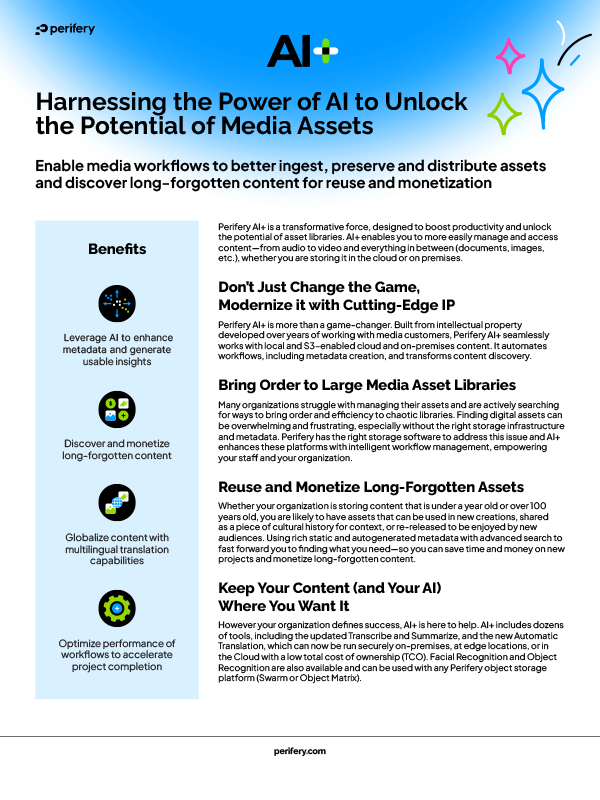
Opportunities for monetization are rife, yet traditional storage solutions often put barriers in the way of the potential. A key factor here is the technology and its ability to integrate with other solutions. If the technology doesn’t flow, creativity certainly can’t! And nothing disrupts a workflow more than disjointed and cumbersome tools.
Media and entertainment organizations have vast archives full of ready-made content, waiting to be given a new lease of life. The fact that you have existing content ready to exploit is great, but its only half the story. To maximize the value of your assets and generate a worthwhile stream of revenue, you need to ensure your media workflow is watertight.
Before we dive into the makings of the perfect content monetization workflow, let’s explore some of the strategies you might be considering:
Subscriptions
Offering additional premium content and exclusive features on a subscription basis is a great way to increase revenue. Subscribers pay a recurring fee to access the content – you get to share all that behind-the-scenes content you thought would never see the light of day, and the subscriber get to feel closer to the action. Win-win.
Advertising
Advertising is one of the most common monetization strategies. FAST channels are a fantastic way of utilizing and generating additional revenue from existing content. The consumer gets to watch back-to-back episodes of their favourite 80s sitcom - for free! - and in return, they’re shown some adverts. Media organizations generate revenue from the advertising companies, who pay to get their commercials in front of their target market.
Licensing
Revenue can be generated by giving rights to other parties to use your content. Ownership of the media stays with the content creator, and the licensee gets to distribute it in line with the agreed terms. The content owner can generate a return from the licensing fees, royalties, and renewals.
Whichever monetization strategy you’ve chosen, you’ll need to ensure that your storage system can integrate with the rest of the workflow infrastructure. If it can’t, find one that can! By using a storage solution that facilitates efficient collaboration among internal teams and external partners, you can maximize the potential for success and profitability.
The problem with non-interoperability...
No one likes to be told what to do. So why risk being bound to a single provider?
If you become too dependent on only one provider, you are setting yourself up for major cost implications, limiting flexibility, and restricting innovation. Aside from the long-term issues, vendor lock-in can cause big problems for monetization. It can restrict the implementation of diverse monetization models, as content owners are limited to only those options provided by the vendor’s platform.
Instead of committing yourself to one vendor, choose an interoperable object storage solution that can connect seamlessly with your existing infrastructure. By doing so, you gain the flexibility to select the most suitable monetization options, integrate with third-party services, and retain ownership and control of your data. All in all, you can maximize your revenue potential.
However, vendor lock-in is only the tip of the non-interoperable iceberg.
A lack of interoperability can result in data silos, where data and metadata become segregated. When content is stored in isolated systems, it becomes difficult to identify and retrieve. These islands of data limit collaboration between teams, partner organizations, and other platforms, restricting the ability to monetize content through partnerships.
Incompatible or disjointed storage systems can lead to fragmented content distribution. To cater for different platforms and/or services, media teams may find themselves having to replicate and store assets separately across multiple systems. This fragmentation not only complicates content management and distribution, but the lack of transparency of all content causes delays and inconsistencies, which impacts the monetization process.
By consolidating data into a unified storage system that can be directly accessed, media organizations can remove the barriers to monetizing content.
Considerations
Now you know why you need to choose an interoperable storage system, it’s important to know what to look out for when shopping for the perfect solution.
Some questions to consider, include:
- Is the solution compatible with the rest of our workflow?
- Can it integrate seamlessly with content management systems and distribution channels?
- Is it able to adapt and scale to future storage requirements?
- Will it keep our data secure? And can we maintain control of access controls?
- Can our partners easily access and collaborate on stored content?
Perifery’s products and solutions are designed for seamless integration. Benefit from faster access to your media archive and experience content monetization like never before. Get started on your monetization journey.
